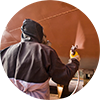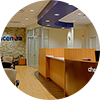
How to Create a Safe Environment with High Employee Turnover
Businesses that exist in high-risk industries face unique occupational health challenges. Factors like heavy machinery, changing outdoor conditions, dangerous materials, and stringent physical requirements can significantly impact safety conditions. These hazards can be magnified by the high employee turnover that often accompanies sectors with large, diverse, and shifting workforces.
New and inexperienced employees may be more prone to making dangerous errors that not only slow productivity, but can often result in expensive treatment, lost wages, and liability costs. A study on the health care industry revealed that a good way to improve safety is to design systems that make errors less common and less harmful when they do occur.
One way to help create better workflow processes is to institute an organizational culture that is focused on creating and maintaining safe work practices. A good organizational culture will foster an atmosphere where employees feel free to communicate and attention to detail is encouraged.
Making personal protective equipment widely available and easily accessible will go a long way towards protecting even the newest employees. This can include helmets, gloves, work boots, and more. Money spent on proper equipment will reduce the risk of unnecessary trips to the emergency room.
Human resources personnel, risk managers, and onsite supervisors should also have a thorough understanding of various job functions. Some positions may be more dangerous and require a certain level of experience to be safely performed. Seeking input from longer-tenured workers can be helpful in defining restricted roles and responsibilities.
Another method for ensuring that new employees are not put in disadvantageous situations is to create small employee groups who work together with a trained supervisor. This supervisor is assigned to stay with the group at all times to act as a liaison between work-forces, deliver instructions, run safety inspections, and check for potential dangers.
It’s important to monitor the condition of the worksite itself. This means a clean environment that is free of debris and unnecessary materials. Sending inspectors to walk through the worksite before shift changes may help uncover potential hazards.
Using large print pictographs is a great way to improve safety. These signs are designed to be universally understood and can leap over language barriers. If prominently displayed, these pictures can help instruct employees on the proper ways to lift objects, use machines, and handle materials. It’s a good idea to use eye-catching, brightly colored signs near areas of potential danger.
It’s very possible to create a safe work environment even when dealing with a workforce that has high turnover rate. With a few key changes, any business can become safer. To summarize:
- Create an organizational culture focused on safety
- Make personal protective equipment widely available
- Understand and limit job functions where appropriate
- Use a trained supervisor to watch over new employees
- Make sure that the work-site is safe and clean
- Post large pictographs to communicate necessary safety information.
If you are interested in having a medical expert tour your worksite and provide input on possible areas for improvement, contact one of our occupational medicine program experts.



